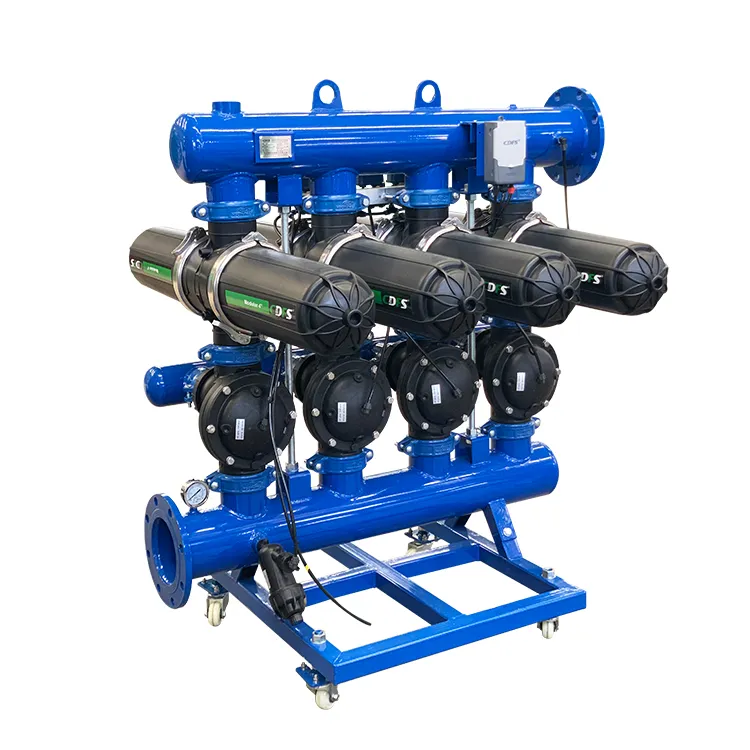
Disc filters are known to be the best to achieve high efficiency in terms of removing fine particles and protecting even the most sensitive downstream equipment. These filters are still used in the same way in irrigation, industrial and water treatment systems. Proper assembly and disassembly are the main factors for the consistent performance and system stability to the end of the filters' long service life. The 4 inch 3 pcs filter is a perfect example of a filtration technology that is both modular and intelligent in its cleaning functions while also being highly moire of high capacity and reliable operation in demanding environments.
The 4 inch 3pcs automatic backwash disc filter has a large water system filtration, the outlet and inlet measure 4 inches. The filter is designed as a three-unit modular, which means that it can be installed in a scale-up manner, and it has an automatic backwashing mechanism that cleans the discs without interrupting the filtration process. The entire system is monitoring by the sensors-throughout the cycle of self-cleaning-and control valves to optimize the water flow, even in changing quality of the water. Those very features make the device a perfect choice for agriculture, municipal systems and industrial water reuse projects.
Before starting to assemble, a clean working area and the tools such as wrenches, lubricants and pressure gauges must be prepared. Inspect all parts—discs, seals, O-rings and housing—for cracks, signs of wear and dirt. Clean and very lightly lubricate the O-rings to reduce wear and prevent leakage during installation. For modular designs like the three-piece system, ensure that the alignment is correct for each unit before joining to avoid uneven pressure or fitting issues.
Assembly begins with a stable setup, at first, to set the filter base not on a flat surface, but on a solid and stable one, mopped and undamaged sealing edges as the next step. The disc stacks are then inserted in proper order according to their micron rating with the discs being compressed evenly on the central spine. Next, the compression spring or clamp is tightened with even pressure thus maintaining the sealing uniformly. Three units are connected to each other through flanges or clamps very securely, but at the same time the alignment is verified with all the connections being accurate. Automatic backwash system, sensors, and control valves installed according to the wiring and hydraulic instructions provided by the manufacturer. Lastly, a pressure test is done to assure no leaks and correct water flow direction.
Disassembling the unit on a regular basis is one of the main activities that will prolong the life of the disc filter. The system should always be completely depressurized before starting. Care should be taken to disconnect the automatic backwash components without damaging the sensors and control units. Open up the housing and take out the disc stacks, washing each disc with water or blowing it clean with compressed air. Check all the sealing elements for wear and replace if necessary. When reassembling, replace the discs in their original sequence and tighten all components correctly to reinstate sealing.
Apart from improper handling, reduced filtration efficiency or equipment damage can be the result. The most basic, yet most common mistakes are: over-tightening of bolts which can lead to the deforming of the housing or O-rings; misaligning the disc stacks which can result in uneven filtration; and neglecting lubrication which may lead to leaks. Apart from these errors, another that is often committed is not taking into account the backwash control system calibration, which would be responsible for incomplete cleaning cycles and pressure imbalance.
The 4 inch 3pcs automatic backwash disc filter, when improperly handled, results in inconsistent water quality and maximum maintenance downtime. The right assembly not only increases flow uniformity but also guarantees stable backwashing, while the careful disassembly allows for easier inspection and replacing of worn parts. These activities have a direct impact on the safety of the operation, they also make the filter life longer and maintenance cost lower in the long run—these are the main advantages for those who operate water systems with high demand.
The activities of disc filter assembly and disassembly should not be viewed merely as routine maintenance—they are critical operations that set filtration performance, reliability, and life of the system. The operators can manage to the utmost the 4 inch 3pcs automatic backwash disc filter by implementing the specified and recommended methods of the manufacturer, thus attaining the long-term operational efficiency through different applications.
1. What assembly tools are needed for disc filter?
Usually, the basic hand tools like wrenches, lubricants, and pressure gauges are among the main ones for the proper installation.
2. How frequently the disc filter should be taken apart for cleaning?
Inspection and cleaning are suggested every three to six months, based on water quality and usage frequency.
3. Is the automatic backwash system doing the dirty work instead of manual cleaning?
The system indeed flushes the discs automatically thus, it requires less manual intervention but still consistent filtration is kept.
4. Why a 4 inch 3pcs automatic backwash disc filter?
This type is great for big scale water systems because of its high flow rate, modular flexibility, and dependable backwash automation.
5. What the filter will suffer if assembled wrong?
Wrong installation may lead to leaks, decreased pressure, and poor filtration; thus, the system will be less reliable overall.

